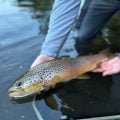Rigs and Methods for Dry Flies on Still Waters
YOU’LL USUALLY FISH DRY FLIES on lakes and ponds when you see trout rising to work a hatch of aquatic insects, a fall of terrestrial insects, or a flight of returning aquatic insects. Such feeding is usually localized, often over a shallow weedbed or near a stand of shoreside trees. The trout will often feed in pods, a loose gathering of trout that either remains in a specific area or cruises slowly through an area much as a single trout might move.
You’ll fish dry flies less often to sporadic, occasional, and scattered rises, which indicate that no hatch, terrestrial feeding, or spinner fall is happening and that just a few cruising trout are finding a few insects on the surface. A searching situation, when no trout are rising but conditions give you hope that you might bring some trout to the surface, might be worth trying with a dry fly, but you’ll have more success in streams than in stillwaters. Unlike in a stream, where an insect on the surface is usually within sight and striking distance of trout at the bottom, trout holding on a lake bottom are not likely to go to the top to take a single insect, or your fly.
Rising, feeding fish. When you find rising trout, avoid rushing out into the middle of them and thrashing around with whatever fly you already have tied to your leader. Instead, back away from them and spend some time watching to see what they’re taking, and whether their movements have a pattern. Then follow a specific set of steps to catch them.
First, collect a natural insect without disturbing the feeding fish. Use an aquarium net, your landing net, or whatever else you can to lift a specimen off the surface. Observe it nose-close, the way a trout does just before it sips it. Notice its size, shape, and color. A trout sees the insect’s underside; tip it up and look at it from that direction. The color will usually be different on the belly, which is the side you want to match, than on the back.
 Second, choose a fly that is at least roughly the same size, shape, and color as the natural you’re holding in your hand. Hold them side-by-side, and make sure your fly is at least somewhat close in size, shape, and color.
Second, choose a fly that is at least roughly the same size, shape, and color as the natural you’re holding in your hand. Hold them side-by-side, and make sure your fly is at least somewhat close in size, shape, and color.
Third, rig properly to fish the fly. The rig can be as simple as a floating line, a leader 2 to 4 feet longer than your rod, and a 3-foot tippet the right diameter to balance the size fly you’ve chosen. In wind, you’ll want a shorter, stouter leader, and on glassy water you might need to go longer and finer.
Fourth, move into position to fish over the rises with a controlled cast, but without putting the trout down. Your ability to cast long can confer an advantage here, but you don’t want to move out so far that you’re crashing your casts onto the heads of trout. If you have an anchor and the trout are not moving, fix your position before you begin fishing.
Finally, begin placing casts over rises. Get the fly as near to the rise as quickly as you can, and let it sit for at least a minute or two. Resist the temptation to frantically paste the fly into every rise-ring. If trout are moving, one will find it.
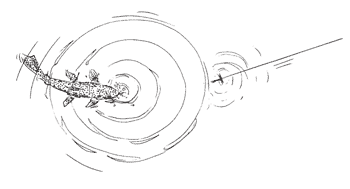 Scattered rises. When rises are occasional and one occurs near enough that you can move to it, do so as quickly as you can so you can get your fly onto the water close to the fish. Let it sit for quite some time. If no trout takes it, then pattern the area with casts placed 10 to 15 feet apart. Let each sit. Be patient; you know at least one active trout is in the area, so don’t chase distant rises until you’ve fished the targeted area with at least a few casts. However, if you can pattern a moving trout, then chase it and get into position ahead of it. If you can place your fly where you might expect its next rise, you’ll have an excellent chance to catch it.
Scattered rises. When rises are occasional and one occurs near enough that you can move to it, do so as quickly as you can so you can get your fly onto the water close to the fish. Let it sit for quite some time. If no trout takes it, then pattern the area with casts placed 10 to 15 feet apart. Let each sit. Be patient; you know at least one active trout is in the area, so don’t chase distant rises until you’ve fished the targeted area with at least a few casts. However, if you can pattern a moving trout, then chase it and get into position ahead of it. If you can place your fly where you might expect its next rise, you’ll have an excellent chance to catch it.
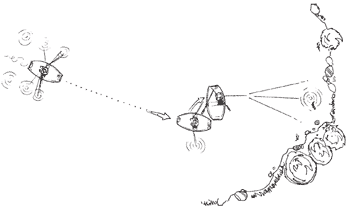 Absence of rises. If no trout are rising but the weather is mild and you see a few insects in the air, then why not see if the trout might respond to a dry fly? Choose a generic fly; a size 12 or 14 Adams resembles many mayflies, midges, and even buzzing caddis. Fish the shoreline, especially along reed and cattail edges, and any structure over shallow water, such as downed trees, rocky points, and lily pad flats. Set your fly over shallow shoreline vegetation or weedbeds, and let it rest. Fish the slight currents of inlets and outlets.
Absence of rises. If no trout are rising but the weather is mild and you see a few insects in the air, then why not see if the trout might respond to a dry fly? Choose a generic fly; a size 12 or 14 Adams resembles many mayflies, midges, and even buzzing caddis. Fish the shoreline, especially along reed and cattail edges, and any structure over shallow water, such as downed trees, rocky points, and lily pad flats. Set your fly over shallow shoreline vegetation or weedbeds, and let it rest. Fish the slight currents of inlets and outlets.
If you fail to catch fish, don’t persist too much longer with the dry, unless you’re a dry-fly purist. If trout are not feeding visibly on the surface of a stillwater, you’ll usually just waste time trying to get them to come up and feed there. Instead, switch to a nymph, streamer, or wet fly, and rig to fish it near the bottom.
Rig: Floating Line and Standard Stillwater Leader
Purpose. This is the standard rig for fishing floating flies on stillwaters, and it’s similar to the rig you would use for drys on moving water. Recall that a leader for the smoothest spring creek and tailwater flows and rising trout is extended to a fine tippet. When you fish dry flies on a lake or pond, the water will be as flat as any you encounter on a stream, so your requirements begin just about where the moving water requirements end.
Trout in rich lakes and ponds grow portly and strong. Very often, while stillwater fly fishing, you’ll encounter the conundrum that makes a tippet that is fine enough to fool the trout too weak to hold it. Keep that balance in mind, and try to choose a tippet that gives you some hope of hooking trout and landing them.
History/origins. The history of dry flies on lakes reaches back to the days when gut leaders were used. Silkworm gut could only be extruded to about 14 inches, so that became the maximum length available for tippet. Gut of 4X was fine, but 5X was fragile at best and undependable on average. Monofilament, once it became available, allowed for the extension of leaders, and as quality improved over the years, so did the strength and dependability of tippets.
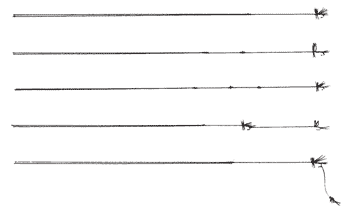 Knots and notes. The rig begins with a weight-forward floating line in a minimum 4-weight and more often 5- or 6-weight. The base leader should be a tapered 3X, 9- or 10-footer. You can add a 3- or 4-foot, 4X tippet, or 1-foot tapering sections and finer tippet. If the water surface is glassy and the insect you’re matching small, you might extend your leader out 15 to 18 feet. The average length for lake fishing with drys would be between 12 and 14 feet. Although often an advantage, fluorocarbon pulls small drys under and therefore is not useful with any drys lacking flotation.
Knots and notes. The rig begins with a weight-forward floating line in a minimum 4-weight and more often 5- or 6-weight. The base leader should be a tapered 3X, 9- or 10-footer. You can add a 3- or 4-foot, 4X tippet, or 1-foot tapering sections and finer tippet. If the water surface is glassy and the insect you’re matching small, you might extend your leader out 15 to 18 feet. The average length for lake fishing with drys would be between 12 and 14 feet. Although often an advantage, fluorocarbon pulls small drys under and therefore is not useful with any drys lacking flotation.
Use blood or surgeon’s knots to connect tapering and tippet sections. Fix conventional dry flies to the tippet with the improved clinch knot. If you’re using surface-film emergers, or drys such as Klinkhamer Specials that suspend from a parachute hackle, use the Duncan or surgeon’s loop to let the fly dangle properly.
As you would on moving waters, you can add either floating emergers or nymphs beneath your drys. The sunk fly should be a size smaller than the dry, and the tippet one diameter finer than the tippet to the dry.
Adjustments for conditions. The only adjustments that should be made to the rig when dry-fly fishing are extending the tippet when conditions are calm and trout are snotty and reducing the length of the leader when wind is a factor. Fortunately, a wind that makes presentation difficult with a long and fine leader also roughens the water and makes the long, fine leader less necessary.
Rules for the rig. The outfit and leader you use should always be light enough so that your fly lands lightly on the water. If your line tip, leader, and fly crash in, back away and rerig, trying a lighter rod and line if you have one. On the other hand, the outfit should be heavy enough to cast in the conditions under which you fish. If the wind is up, you will be glad you have your 6-weight. If your leader is tapered correctly and your casting careful enough, this rod can be delicate enough for almost all stillwater situations.
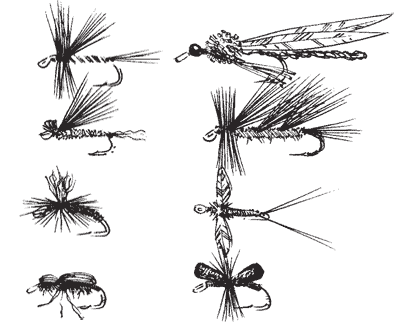 The leader must be able to turn over the flies you’re casting. At times, you might find trout feeding on large drys and demanding fine tippets, but that is rare. Be sure that your leader always turns over, extends, and sets the fly down gently. The pile cast works over moving currents on streams, but it’s fatal on lakes.
The leader must be able to turn over the flies you’re casting. At times, you might find trout feeding on large drys and demanding fine tippets, but that is rare. Be sure that your leader always turns over, extends, and sets the fly down gently. The pile cast works over moving currents on streams, but it’s fatal on lakes.
One final rule: Don’t let your tippet get much shorter than a couple of feet. If repeated fly changes shorten it, clip it off and tie on a new 3- to 4-foot tippet.









